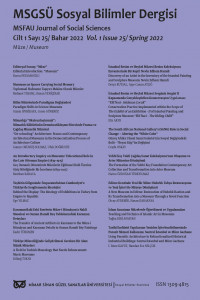Thomas Aquinas’ta Sanat: Güzel ve İyi
Thomas Aquinas, Sanat, Güzel, İyi, Estetik
Art in Thomas Aquinas: The Beautiful and the Good
Thomas Aquinas, Art, Beautiful, Good, Aesthetics.,
___
- AKARSU, Bedia. Felsefe Terimleri Sözlüğü. Ankara: Türk Dil Kurumu Yayınları. 1975.
- ARISTOTALES. La Métaphysique. Çev. Jules Barthélemy-Saint-Hilaire. Paris: Agora. 2004.
- ARISTOTALES. Traité De L’Âme. Çev. Jules Barthélemy-Saint-Hilaire. Paris: Librairie Philosophique de Ladrange. 1923.
- ECO, Umberto. Art et Beauté Dans L’Esthétique Médiévale. Çev. Maurice Javion. Paris: Édition Grasset&Fasquelle. 1997.
- ECO, Umberto. Le Problème Esthétique chez Thomas d’Aquin. Çev. Maurice Javion. Paris: PUF. 1993.
- D’AQUIN, Thomas. 2014. Commentaire de Saint Thomas d’Aquin sur « Les Noms Divins » de Denys le Mystique. C.4, 7, Çev. Serge Pronovost, Neuville, http://docteurangelique.free.fr/bibliotheque/ opuscules/85CommentaireNomsDivinsSaintDenis.htm, erişim tarihi: 25.07.2016.
- D’AQUIN, Thomas. Commentaire Du Traité De L’Âme D’Aristoteles. Çev. Jean-Marie Vernier. Paris: Librairie Philosophique J.Vrin. 1999.
- D’AQUIN, Thomas. 2004. De Principii Naturae, Editions Louis Vivès (1857), Édition numérique, http://docteurangelique.free.fr/saint_thomas_d_aquin/oeuvres_completes.html, erişim tarihi : 25.03.2016
- D’AQUIN, Thomas. 1996. L’Être et L’Essence, Çev. Alain de Libera, Cyrill Michon. Editions du Seuil. Paris. http://remacle.org/bloodwolf/philosophes/Aristote/ame2.htm, erişim tarihi: 25.03.2016.
- D’AQUIN, Thomas. Somme Contre Les Gentils. GF Flammarion. Çev. Cyrille Michon. Paris: Vincent Aubin et Denis Moreau. 1999.
- D’AQUIN, Thomas. Somme Théologique, Çev. Aimon-Marie Roguet, Cerf. 1984.
- D’AQUIN, Thomas. 2012. Sur La Vérité. III, 1. Fransa, http://docteurangelique.free.fr/ bibliotheque/questionsdisputees/questionsdisputeessurlaverite.htm, erişim tarihi: 25.03.2016
- GAFFIOT, Félix. Dictionnaire Latin-Française. Paris: Hachette. 1934.
- HARPER, Douglas. Online Etimology Dictionary. http://www.etymonline.com/index.php?searc h=cosmos&searchmode=none. erişim tarihi: 25.03.2016
- KABAAĞAÇ, Sina, Alova, Erdal. Latince-Türkçe Sözlük. İstanbul: Sosyal Yayınları. 1995.
- SCHÜTZ, Ludwig. 2006. Thomas-Lexikon, “claritas” maddesi. 3. Auflage von Enrique Alarcón vorbereitet Pamplona, Universität von Navarra, http://www.corpusthomisticum.org/tlc. html#claritas, erişim tarihi : 25.03.2016
- DE WULF, Maurice. Philosophy and Civilization in the Middle Ages. New Jersey: Princeton University Press. 1924.
- PANOFSKY, Erwin. Gotik Mimarlık ve Skolastik Felsefe. Çev. Engin Akyürek. İstanbul: Kabalcı Yayınevi. 1995.
- PLATON. Œuvre Complètes “Parménide”, III. Çev. Émile Chambry. Paris: Librairie Garnier Frères. 1950.
- PLATON. Œuvre Complètes “La République”, VII. Çev. Léon Robin. Paris: Bibliothèque de la Pléiade. 1940.
- PLATON. Timaios. Çev. Erol Güney, Lütfi Ay. Cumhuriyet. 2001.
- Tüm latince orijinal metinler http://www.corpusthomisticum.org, erişim tarihi: 26.08.2016
- ISSN: 1309-4815
- Yayın Aralığı: Yılda 2 Sayı
- Başlangıç: 2010
- Yayıncı: Mimar Sinan Güzel Sanatlar Üniversitesi
Soyut Sanata Fenomenolojik Bir Yaklaşım
The Schoenberg Phenomenon: Twelve-tone Music and its Absolute Alienation
Thomas Aquinas’ta Sanat: Güzel ve İyi
Hegel Estetiğinin Modern Heykeldeki Yeri
Robert Musil’in Etik ve Estetik Anlayışı: Bir Yazma ve Yaşama Biçimi Olarak Denemecilik
Sanat Yapıtının Fenomenolojisi
Locales of Art: Synaesthesia and the Interruptions of Orientational Aesthetics
